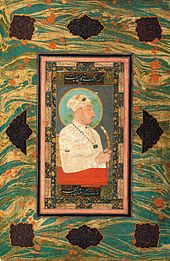Muhammad Shah
Muhammad Shah , also Muhammad Shah Rangila (born August 7, 1702 in Ghazni ; died April 16, 1748 in Delhi ) was the 12th Grand Mughal of India from 1720 to 1748. Under his rule included the actual territory of the Grand Mughal after military defeats soon only the region around Delhi and Agra .
Live and act
His predecessor Farrukh Siyar was murdered in 1719 by a palace intrigue of the Sayyids, two brothers who served as commanders at the Mughal court and who had risen to become a major power factor at the court.
Muhammad Shah prevailed in a bloody power struggle against Shah Jahan II (11th Grand Mughal) and other heir to the throne and had the Sayyids executed. Otherwise he left power to the other interest groups that had formed at the imperial court since Bahadur Shah I. Under the government of Muhammad Shah, who was considered lazy and voluptuous, large parts of the taxes at court were wasted and the administration was limited to appointing the governors, who then had to see for themselves how and whether they could assert themselves in their province. The replacement of a governor by a new one and the collection of taxes was tantamount to war, so that in the end hardly any taxes were sent to Delhi. In 1723 he made Urdu the court language of India. In 1724 Muhammad Shah's vizier Asaf Jah I resigned. He de facto detached his province of Dekkan from the imperial union and ruled it as the Nizam of Hyderabad . The empire thus lost a third of its state income and almost three quarters of its war material. The Afsharid ruler of Persia , Nader Shah , took advantage of the empire's weakness . In 1739 he defeated the Mughal army at the Battle of Karnal, north of Delhi, not far from the historical battlefields of Panipat , and entered Delhi peacefully by agreement . When an uprising broke out against him, he caused a massacre, sacked the entire city, including the Mughal treasury, and returned to Persia. In doing so, he dealt the death blow to the Mughal Empire as an empire spanning all of India. The process of “ regionalization of power ”, which had already started earlier, now continued rapidly and soon restricted the real territory of the Grand Mogul to the region around Delhi and Agra . Bengal and Avadh actually achieved independence, even if they formally recognized the suzerainty of the Mughal emperor and paid symbolic tributes. The Persian border was moved to the Indus . At the same time the Marathas expanded to Malwa and Gujarat . At the Battle of Manupur in 1748, the Mughal troops were able to prevail against the advancing Afghan ruler Ahmad Shah Durrani . A few days later, however, Muhammad Shah died in Delhi.
His weak successors had nothing left to oppose the Afghans.
literature
- Stephan Conermann: The Mughal Empire. History and Culture of Muslim India. (= Beck series 2403 CH Beck Wissen ). Beck, Munich 2006, ISBN 3-406-53603-4 .
- Hermann Kulke, Dietmar Rothermund: History of India - From the Indus culture to today. Beck, Munich 2017, ISBN 978-3-406-72064-2 .
Web links
Individual evidence
- ↑ Hans-Georg Behr : The Mughals. Power and splendor of the Indian emperors from 1369–1857. Econ Verlag, Vienna / Düsseldorf 1979, p. 254.
- ↑ The massacre allegedly killed more than 30,000 people. The booty carried by Nadir Shah's troops, which allegedly also included Shah Jahan's famous peacock throne, is said to have been worth a billion rupees. Stanley Wolpert: A New History of India , New York 1982 (2nd edition), p. 173.
- ↑ Kulke / Rothermund, p. 284.
| predecessor | Office | successor |
|---|---|---|
| Shah Jahan II |
Mughal Mughal of India 1719 / 20–1748 |
Ahmad Shah |
| personal data | |
|---|---|
| SURNAME | Muhammad Shah |
| ALTERNATIVE NAMES | Muhammad Shah Rangila |
| BRIEF DESCRIPTION | Mughal Mughal of India (1720 to 1748) |
| DATE OF BIRTH | August 7, 1702 |
| PLACE OF BIRTH | Ghazni |
| DATE OF DEATH | April 16, 1748 |
| Place of death | Delhi |

